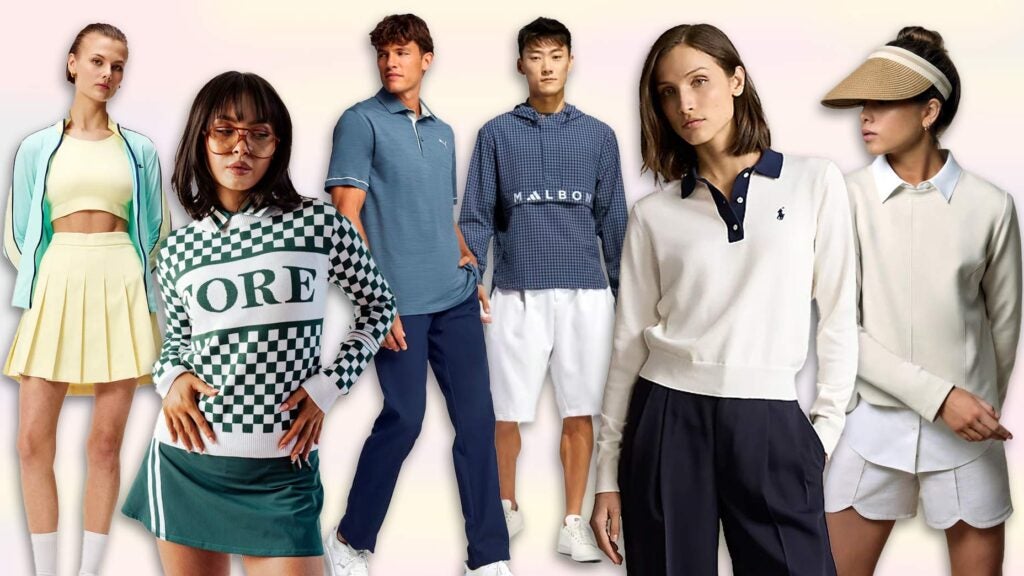Branded Clothing That Lasts: Choosing Fabrics for Longevity
Branded Clothing That Lasts: Choosing Fabrics for Longevity
Blog Article
The Value of Sustainable Clothes: How It Impacts the Setting and Your Storage room
Lasting garments is progressively recognized for its essential duty in decreasing the ecological effect of the fast apparel industry. By concentrating on environment-friendly materials and moral production approaches, it deals with pressing eco-friendly issues. This change not only benefits the planet however likewise influences consumer selections, causing an extra thoughtful method to wardrobe administration. Understanding these dynamics elevates important questions regarding fashion's future and individual obligation in forming it.
The Ecological Impact of Quick Style

Benefits of Sustainable Products
Sustainable materials supply substantial advantages, specifically via eco-friendly textile options that reduce ecological injury. These products additionally demonstrate sturdiness and longevity, decreasing the need for regular replacements. As an outcome, they add to a more lasting fashion industry and advertise liable customer behavior.
Eco-Friendly Fabric Selections
While the garment industry has long been related to rapid patterns and environmental damage, the rise of environment-friendly fabric selections provides a transformative opportunity. Lasting materials such as natural cotton, hemp, and Tencel have actually acquired appeal due to their lower ecological effect. These fabrics are frequently produced without dangerous pesticides and call for less water, reducing their carbon impact - Branded Clothing. Additionally, many eco-friendly textiles are biodegradable, adding to a circular economic situation by lessening waste. Picking sustainable products not only sustains environmentally accountable techniques but additionally advertises much healthier ecosystems. As consumers come to be extra familiar with their buying power, the need for eco-friendly fabrics encourages brand names to introduce and take on even more lasting manufacturing methods, eventually profiting the planet and future generations
Resilience and Durability Advantages
Several consumers are progressively identifying the durability and durability benefits of lasting products in their clothing options. Unlike traditional materials, lasting products such as natural cotton, hemp, and recycled polyester are crafted to endure deterioration, causing garments that last much longer. This minimized regularity of replacement not only saves consumers money over time but additionally lessens waste generated by rapid fashion. Additionally, lasting clothing commonly employs eco-friendly manufacturing methods that improve fabric toughness, adding to a reduction in the general carbon impact. By purchasing durable garments, consumers can cultivate a more sustainable closet while appreciating premium items that preserve their aesthetic and functionality over time. Resilience and long life stand as crucial advantages of picking lasting materials.
Reducing Waste Via Lasting Practices
Decreasing waste in the fashion business can be achieved via ingenious techniques such as upcycling and repurposing products. Furthermore, taking on minimalist wardrobe strategies motivates customers to prioritize top quality over quantity, ultimately lowering clothing intake. Together, these approaches add substantially to a much more sustainable apparel design.
Upcycling and Repurposing Materials
Upcycling and repurposing products have become ingenious strategies in the apparel industry, transforming discarded fabrics right into valuable new items. This strategy not only lessens waste but additionally motivates creativity and uniqueness in clothing style. By taking old garments and materials, developers can produce one-of-a-kind pieces that show individual design while minimizing the need for brand-new resources. In addition, upcycling usually requires less energy and water contrasted to typical production processes, substantially lowering the environmental footprint of style. As customers come to be more conscious of sustainability, the popularity of upcycled clothing remains to rise, promoting a round economic situation. Eventually, these techniques add to a much more lasting future, where style prioritizes ecological health and wellness over quick manufacturing and intake.

Minimal Closet Approaches
As people increasingly seek to reduce their environmental effect, embracing minimalist wardrobe methods has acquired traction as an efficient method to lasting style. These approaches stress quality over quantity, motivating customers to curate a smaller sized collection of functional, sturdy apparel. By concentrating on classic items that can be blended and matched, individuals can decrease the frequency of purchases and ultimately reduce waste.Additionally, minimalism promotes mindful intake, prompting buyers to review the ecological and honest ramifications of their options. This method not only fosters an extra lasting way of life however likewise simplifies everyday decision-making concerning clothes. As individuals embrace minimalist principles, they contribute to a style society that values sustainability and accountable consumerism, inevitably bring about a much more eco-conscious society.
The Duty of Honest Labor in Lasting Style
While numerous consumers are progressively conscious of the ecological consequences of their clothing choices, the value of honest labor practices in sustainable style can not be ignored. Ethical labor includes reasonable earnings, safe working problems, and respect for employees' rights, creating the backbone of accountable style production. Brand names that focus on moral labor not only boost communities however additionally set a criterion for accountability in the industry.Moreover, the assimilation of ethical techniques promotes transparency, making it possible for consumers to make educated choices concerning their purchases. This technique contrasts dramatically with quick style's unscrupulous labor models, which typically focus on earnings over people. By sustaining companies dedicated to honest labor, consumers add to a system that values human dignity together with ecological sustainability. Consequently, honest labor is not merely an add-on; it is vital to the broader objective of lasting style, making certain that the quest for eco-friendliness does not come with the expense of human legal rights.
The Influence of Lasting Apparel on Carbon Emissions
Lasting clothes has the potential to significantly reduce carbon exhausts linked with the apparel industry. Standard garment imp source production contributes especially to greenhouse gas exhausts, mainly due to energy-intensive production procedures and the use of non-renewable resources. On the other hand, sustainable style concentrates on environment-friendly materials, such as organic cotton or recycled fibers, which often discover here require less energy to produce.Moreover, sustainable brand names have a tendency to take on a lot more effective production methods, reducing waste and decreasing total discharges. By focusing on toughness and ageless layout, sustainable clothing urges consumers to acquire much less frequently, further lowering the carbon impact associated with overconsumption.Additionally, lots of lasting brands are devoted to openness in their supply chains, enabling consumers to make enlightened choices that line up with their worths. Ultimately, shifting towards sustainable apparel can result in a considerable reduction in carbon discharges, adding to a healthier earth and a more sustainable future for the apparel industry.
Sustaining Local Economic Situations With Sustainable Options
The change toward sustainable apparel not only addresses environmental worries but likewise substantially benefits regional economic situations. By choosing sustainable fashion, customers frequently sustain local artisans and local business, improving area resilience. These business typically operate a smaller sized scale, focusing on craftsmanship and moral practices over mass production.Investing in locally made sustainable clothing promotes task development and promotes economic development within areas. As customers become extra knowledgeable about the environmental influence of their acquisitions, they significantly choose products that reflect their values. This demand encourages local manufacturers to adopt lasting techniques, adding to a circular economy.Moreover, sustaining regional services lowers transportation discharges, lining up with eco-conscious consumer behavior. The interconnectedness of lasting clothes and regional economies underscores the important role that specific options play in promoting both ecological and economic health. By fostering these neighborhood links, neighborhoods can thrive while additionally functioning towards an extra sustainable future.
Transforming Your Storage Room: Tips for a Lasting Wardrobe
As people seek to lower their environmental impact, changing a closet right into a sustainable wardrobe becomes a necessary step. One reliable method is to evaluate existing garments, keeping just products that are worn on a regular basis and that line up with sustainability goals. Focusing on high quality over quantity is essential; spending in sturdy items from green brands can considerably decrease waste.Additionally, including used items can take a breath new life into a closet while reducing environmental damages. Organizing clothing swaps with good friends or donating extra things can additionally advertise sustainability.When purchasing, individuals must look for materials that are organic, recycled, or naturally degradable, and stay clear of fast fashion merchants - Branded Clothing. Ultimately, practicing conscious consumption by thoughtfully taking into consideration each acquisition can add to a more sustainable way of life. By implementing these suggestions, one can develop a closet that reflects personal design while supporting ecological stewardship
Often Asked Inquiries
Exactly How Can I Identify Lasting Clothing Brands?
To recognize sustainable clothes brand names, one need to investigate materials utilized, look go now for qualifications like Fair Trade, and analyze the brand name's openness concerning their manufacturing procedures, labor methods, and ecological effect, guaranteeing environment-friendly and honest methods are prioritized.
What Are the Costs Connected With Sustainable Fashion?
The costs connected with lasting fashion can vary considerably. Greater manufacturing costs, ethical sourcing, and eco-friendly products frequently lead to increased list prices, which might hinder some customers while interesting ecologically conscious shoppers.
Can Sustainable Apparel Be Fashionable and Stylish?
Lasting clothes can indeed be fashionable and stylish. Developers significantly prioritize innovative products and honest production methods, confirming that style and sustainability can exist together. Consumers now have varied choices that blend aesthetic appeals with ecological consciousness.
Just How Does Washing Clothes Affect Their Sustainability?
Washing garments substantially effects sustainability by consuming water and power, adding to contamination, and causing microplastic release. Regular washing can break down fabrics, reducing their lifespan and raising the need for replacements, inevitably intensifying ecological concerns.
What Is the Life Expectancy of Lasting Apparel Compared to Quick Style?
The lifespan of sustainable garments normally exceeds that of quick fashion things, often enduring a number of years because of high quality products and workmanship. On the other hand, rapid style garments might degrade promptly, necessitating more regular replacements. Sustainable garments is significantly identified for its crucial function in minimizing the environmental impact of the fast fashion market. While several customers are increasingly conscious of the environmental effects of their apparel options, the significance of ethical labor practices in sustainable fashion can not be overlooked. Branded Clothing. Lasting apparel has the possible to significantly decrease carbon discharges connected with the style market. In contrast, sustainable fashion focuses on environment-friendly products, such as natural cotton or recycled fibers, which frequently need less energy to produce.Moreover, sustainable brands often tend to embrace more effective production methods, decreasing waste and lowering total exhausts. By prioritizing longevity and classic layout, sustainable clothing motivates consumers to buy much less frequently, more minimizing the carbon footprint linked with overconsumption.Additionally, many lasting brands are devoted to openness in their supply chains, enabling consumers to make enlightened selections that line up with their values
Report this page